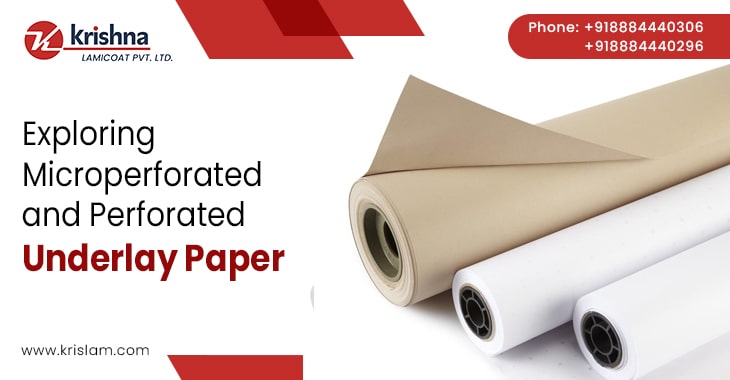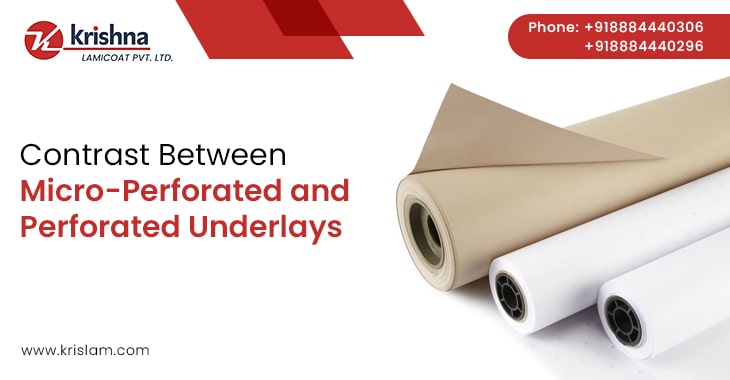
An unsung hero in the textile manufacturing realm is underlay paper, not just any underlay paper but Microperforated and Perforated Underlay paper manufactured by the industry leader, Krishna Lamicoat. This blog I’ll delve into the significance of Microperforated and Perforated Underlay paper, highlighting its role in enhancing fabric performance.
- Precision at a Pre-determined Distance
- Uniform Vacuumization
- Tailored Solutions for Various Fabrics
- Enhancing Efficiency and Quality
- Environmentally Responsible Manufacturing
Precision at a Pre-determined Distance:
A fundamental aspect of textile manufacturing is ensuring that the fabric is firmly in place during various stages of production. This requires precise control over the tension and movement of the fabric. This is where underlay paper comes into play. Underlay paper is designed to provide a stable surface for the fabric to rest upon, preventing distortion, wrinkles, and slippage during cutting, sewing, and embroidery processes.
Krishna Lamicoat’s microperforated and perforated underlay paper furthers this concept by offering unparalleled precision. The micro-perforations are strategically placed at predetermined distances to suit the specific fabric used. This meticulous approach ensures the fabric remains securely in place, minimising any chance of misalignment or errors during production.
Uniform Vacuumization:
Another critical factor in textile manufacturing is the application of vacuum suction to hold the fabric in place during cutting and embroidery. Uneven vacuumization can lead to fabric distortion and errors in pattern placement. Krishna Lamicoat‘s microperforated and perforated underlay paper is precisely punched to facilitate uniform vacuumization.
This underlay paper guarantees consistent suction across the fabric’s surface by ensuring that the perforations are uniformly distributed. This enhances the accuracy of cutting and embroidery and reduces fabric wastage due to misalignment or uneven tension.
Tailored Solutions for Various Fabrics:
Not all fabrics are created equal, and each type has unique challenges. Krishna Lamicoat understands the diverse needs of the textile industry and offers a range of microperforated and perforated underlay papers designed to cater to specific fabric requirements. Whether you’re working with delicate silks, sturdy pieces of denim, or stretchy knits, Krishna Lamicoat’s underlay papers can be customised to ensure optimum performance for your chosen fabric.
Enhancing Efficiency and Quality:
Microperforated and perforated underlay paper goes beyond merely preventing fabric distortion. It enhances overall efficiency in textile manufacturing. The production process becomes more streamlined with precise perforations that facilitate uniform vacuumization, resulting in reduced downtime and increased throughput. This not only saves time but also boosts cost efficiency.
Moreover, the improved accuracy achieved with Krishna Lamicoat’s underlay paper translates into higher-quality finished products. Whether you’re producing intricate embroidery designs or perfectly cut patterns, the underlay paper plays a pivotal role in ensuring that every piece meets the highest quality standards.
Environmentally Responsible Manufacturing:
Krishna Lamicoat is committed to sustainable and environmentally responsible manufacturing practices. The company utilises eco-friendly materials to produce microperforated and perforated underlay papers, minimising its carbon footprint. Additionally, the precision engineering of these underlay papers reduces fabric waste, contributing to a more sustainable and efficient textile industry.
Conclusion
In the competitive world of textile manufacturing, every detail counts. Krishna Lamicoat’s Microperforated and Perforated Underlay papers are a testament to the industry’s importance of precision and quality. So, the next time you want to elevate your textile production process, remember the unsung hero – microperforated and perforated underlay paper from Krishna Lamicoat, India. You can also check out our Poly Overwrap Film and other products.
 An ISO 9001 and Govt. recognised Star Export house
An ISO 9001 and Govt. recognised Star Export house
